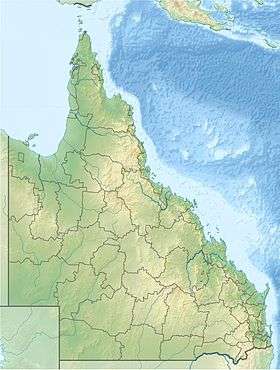Cedar Bay National Park
| Cedar Bay National Park Queensland | |
|---|---|
|
IUCN category II (national park) | |
|
Cedar Bay National Park | |
 Cedar Bay National Park | |
| Nearest town or city | Cooktown |
| Coordinates | 15°46′37″S 145°20′47″E / 15.77694°S 145.34639°ECoordinates: 15°46′37″S 145°20′47″E / 15.77694°S 145.34639°E |
| Established | 1977 |
| Area | 56.5 km2 (21.8 sq mi) |
| Managing authorities | Queensland Parks and Wildlife Service |
| Website | Cedar Bay National Park |
| See also | Protected areas of Queensland |
Cedar Bay is a 56.5 km2 (21.8 sq mi) national park in Queensland, Australia, 1,522 km (946 mi) northwest of Brisbane, 40 km (25 mi) south of Cooktown and accessible only by boat or foot. The park is one of the Wet Tropics World Heritage Area series of national parks, and is a gazetted World Heritage site.[1] It is also known as Mangkal-Mangkalba[2] in the dialect of the local Aboriginal population, the Eastern Kuku Yalanji.[3]
History
The Cedar Bay area was developed in the 1870s for tin mining, and the remains of the tin work can still be seen in the area of Black Snake Rocks. Cedar Bay gained a degree of notoriety in the 1970s when squatters, seeking a different way of life, were evicted from the park. In 2007, the national park was part of the 2,000 square kilometres (770 sq mi) of land handed over to Cape York's Aboriginal population by the Queensland government.[4] The handover came as a result of a 1994 Native Title claim.[5]
It was known as Mount Finnigan National Park before being enlarged.
Activities
The park contains some of the northernmost tropical rainforests in Australia. Birdwatching is a popular activity with the most common birds including cassowaries, yellow-breasted sunbirds, double-eyed fig-parrots, mangrove kingfishers, beach stone-curlews and pied imperial-pigeons. Bush camping is permitted in the park, however fishing and collecting are prohibited. The sole walking track in the park was a former donkey track used by tin miners. It is inaccessible to all but fit walkers.[6]
See also
References
- ↑ "Wet Tropics of Queensland". UNESCO World Heritage Centre. Retrieved 2008-01-29.
- ↑ "Cedar Bay (Mangkal-Mangkalba) National Park". Environmental Protection Agency. Archived from the original on 31 December 2007. Retrieved 2008-01-29.
- ↑ "Aborigines Win Back Cape York Land". The Age. 2007-04-11. Retrieved 2008-01-29.
- ↑ "Qld Govt to Hand Over Cape York Land". The Age. 2007-04-11. Retrieved 2008-01-29.
- ↑ Marszalek, Jessica (2007-04-11). "Aborigines Win Back Cape York Land". The Daily Telegraph. Archived from the original on 19 September 2007. Retrieved 2008-01-29.
- ↑ "Cedar Bay (Mangkal-Mangkalba) National Park". Environmental Protection Agency. Archived from the original on 31 December 2007. Retrieved 2008-01-29.